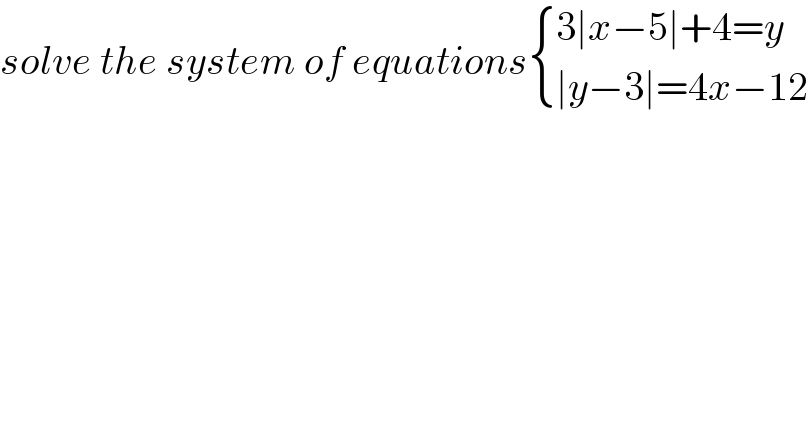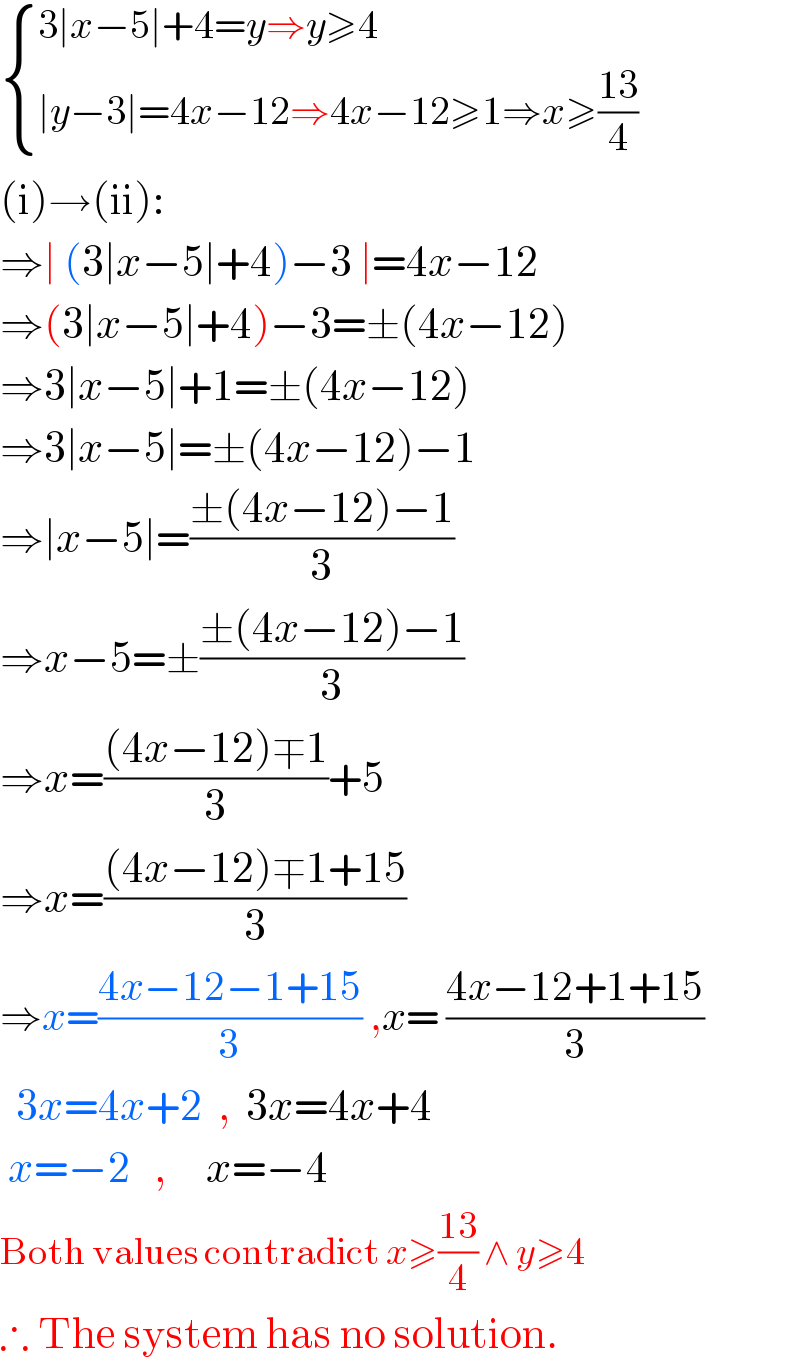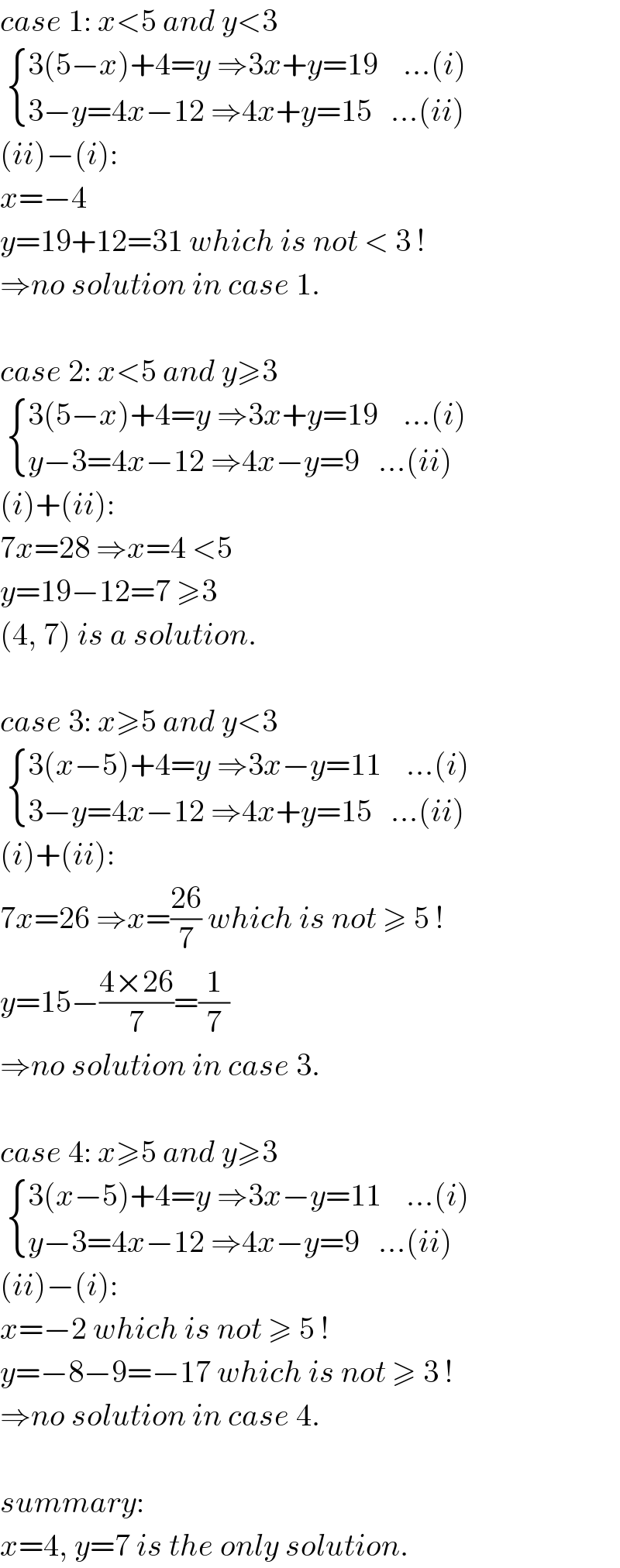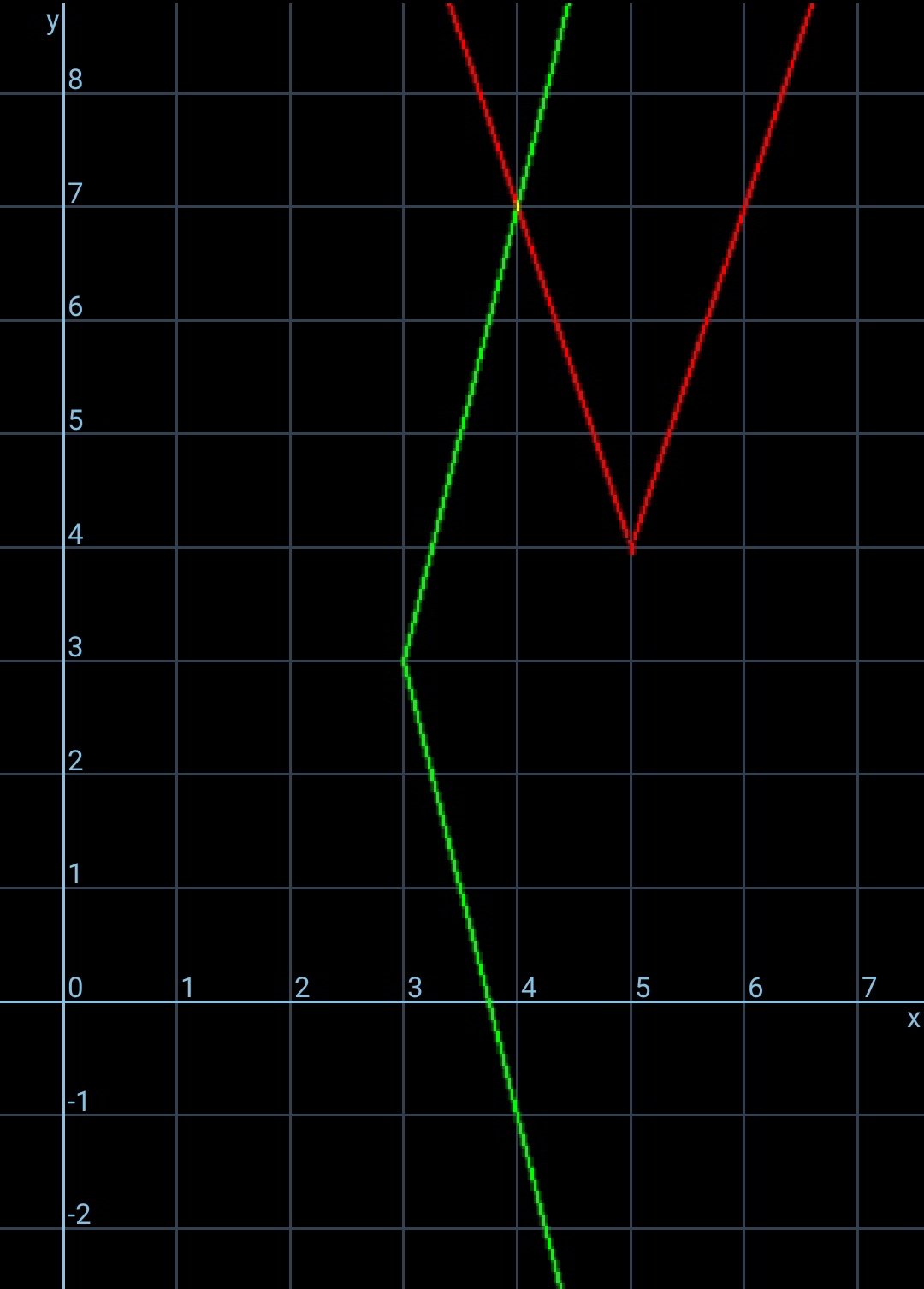
Question Number 67745 by Enock last updated on 31/Aug/19

$${solve}\:{the}\:{system}\:{of}\:{equations\begin{cases}{\mathrm{3}\mid{x}−\mathrm{5}\mid+\mathrm{4}={y}}\\{\mid{y}−\mathrm{3}\mid=\mathrm{4}{x}−\mathrm{12}}\end{cases}} \\ $$
Answered by Rasheed.Sindhi last updated on 31/Aug/19

$$\begin{cases}{\mathrm{3}\mid{x}−\mathrm{5}\mid+\mathrm{4}={y}\Rightarrow{y}\geqslant\mathrm{4}}\\{\mid{y}−\mathrm{3}\mid=\mathrm{4}{x}−\mathrm{12}\Rightarrow\mathrm{4}{x}−\mathrm{12}\geqslant\mathrm{1}\Rightarrow{x}\geqslant\frac{\mathrm{13}}{\mathrm{4}}}\end{cases} \\ $$$$\left(\mathrm{i}\right)\rightarrow\left(\mathrm{ii}\right): \\ $$$$\Rightarrow\mid\:\left(\mathrm{3}\mid{x}−\mathrm{5}\mid+\mathrm{4}\right)−\mathrm{3}\:\mid=\mathrm{4}{x}−\mathrm{12} \\ $$$$\Rightarrow\left(\mathrm{3}\mid{x}−\mathrm{5}\mid+\mathrm{4}\right)−\mathrm{3}=\pm\left(\mathrm{4}{x}−\mathrm{12}\right) \\ $$$$\Rightarrow\mathrm{3}\mid{x}−\mathrm{5}\mid+\mathrm{1}=\pm\left(\mathrm{4}{x}−\mathrm{12}\right) \\ $$$$\Rightarrow\mathrm{3}\mid{x}−\mathrm{5}\mid=\pm\left(\mathrm{4}{x}−\mathrm{12}\right)−\mathrm{1} \\ $$$$\Rightarrow\mid{x}−\mathrm{5}\mid=\frac{\pm\left(\mathrm{4}{x}−\mathrm{12}\right)−\mathrm{1}}{\mathrm{3}} \\ $$$$\Rightarrow{x}−\mathrm{5}=\pm\frac{\pm\left(\mathrm{4}{x}−\mathrm{12}\right)−\mathrm{1}}{\mathrm{3}} \\ $$$$\Rightarrow{x}=\frac{\left(\mathrm{4}{x}−\mathrm{12}\right)\mp\mathrm{1}}{\mathrm{3}}+\mathrm{5} \\ $$$$\Rightarrow{x}=\frac{\left(\mathrm{4}{x}−\mathrm{12}\right)\mp\mathrm{1}+\mathrm{15}}{\mathrm{3}} \\ $$$$\Rightarrow{x}=\frac{\mathrm{4}{x}−\mathrm{12}−\mathrm{1}+\mathrm{15}}{\mathrm{3}}\:,{x}=\:\frac{\mathrm{4}{x}−\mathrm{12}+\mathrm{1}+\mathrm{15}}{\mathrm{3}} \\ $$$$\:\:\mathrm{3}{x}=\mathrm{4}{x}+\mathrm{2}\:\:,\:\:\mathrm{3}{x}=\mathrm{4}{x}+\mathrm{4} \\ $$$$\:{x}=−\mathrm{2}\:\:\:,\:\:\:\:\:{x}=−\mathrm{4} \\ $$$$\mathrm{Both}\:\mathrm{values}\:\mathrm{contradict}\:{x}\geqslant\frac{\mathrm{13}}{\mathrm{4}}\:\wedge\:{y}\geqslant\mathrm{4} \\ $$$$\therefore\:\mathrm{The}\:\mathrm{system}\:\mathrm{has}\:\mathrm{no}\:\mathrm{solution}. \\ $$
Answered by mr W last updated on 31/Aug/19

$${case}\:\mathrm{1}:\:{x}<\mathrm{5}\:{and}\:{y}<\mathrm{3} \\ $$$$\:\begin{cases}{\mathrm{3}\left(\mathrm{5}−{x}\right)+\mathrm{4}={y}\:\Rightarrow\mathrm{3}{x}+{y}=\mathrm{19}\:\:\:\:...\left({i}\right)}\\{\mathrm{3}−{y}=\mathrm{4}{x}−\mathrm{12}\:\Rightarrow\mathrm{4}{x}+{y}=\mathrm{15}\:\:\:...\left({ii}\right)}\end{cases} \\ $$$$\left({ii}\right)−\left({i}\right): \\ $$$${x}=−\mathrm{4} \\ $$$${y}=\mathrm{19}+\mathrm{12}=\mathrm{31}\:{which}\:{is}\:{not}\:<\:\mathrm{3}\:! \\ $$$$\Rightarrow{no}\:{solution}\:{in}\:{case}\:\mathrm{1}. \\ $$$$ \\ $$$${case}\:\mathrm{2}:\:{x}<\mathrm{5}\:{and}\:{y}\geqslant\mathrm{3} \\ $$$$\:\begin{cases}{\mathrm{3}\left(\mathrm{5}−{x}\right)+\mathrm{4}={y}\:\Rightarrow\mathrm{3}{x}+{y}=\mathrm{19}\:\:\:\:...\left({i}\right)}\\{{y}−\mathrm{3}=\mathrm{4}{x}−\mathrm{12}\:\Rightarrow\mathrm{4}{x}−{y}=\mathrm{9}\:\:\:...\left({ii}\right)}\end{cases} \\ $$$$\left({i}\right)+\left({ii}\right): \\ $$$$\mathrm{7}{x}=\mathrm{28}\:\Rightarrow{x}=\mathrm{4}\:<\mathrm{5} \\ $$$${y}=\mathrm{19}−\mathrm{12}=\mathrm{7}\:\geqslant\mathrm{3} \\ $$$$\left(\mathrm{4},\:\mathrm{7}\right)\:{is}\:{a}\:{solution}. \\ $$$$ \\ $$$${case}\:\mathrm{3}:\:{x}\geqslant\mathrm{5}\:{and}\:{y}<\mathrm{3} \\ $$$$\:\begin{cases}{\mathrm{3}\left({x}−\mathrm{5}\right)+\mathrm{4}={y}\:\Rightarrow\mathrm{3}{x}−{y}=\mathrm{11}\:\:\:\:...\left({i}\right)}\\{\mathrm{3}−{y}=\mathrm{4}{x}−\mathrm{12}\:\Rightarrow\mathrm{4}{x}+{y}=\mathrm{15}\:\:\:...\left({ii}\right)}\end{cases} \\ $$$$\left({i}\right)+\left({ii}\right): \\ $$$$\mathrm{7}{x}=\mathrm{26}\:\Rightarrow{x}=\frac{\mathrm{26}}{\mathrm{7}}\:{which}\:{is}\:{not}\:\geqslant\:\mathrm{5}\:! \\ $$$${y}=\mathrm{15}−\frac{\mathrm{4}×\mathrm{26}}{\mathrm{7}}=\frac{\mathrm{1}}{\mathrm{7}} \\ $$$$\Rightarrow{no}\:{solution}\:{in}\:{case}\:\mathrm{3}. \\ $$$$ \\ $$$${case}\:\mathrm{4}:\:{x}\geqslant\mathrm{5}\:{and}\:{y}\geqslant\mathrm{3} \\ $$$$\:\begin{cases}{\mathrm{3}\left({x}−\mathrm{5}\right)+\mathrm{4}={y}\:\Rightarrow\mathrm{3}{x}−{y}=\mathrm{11}\:\:\:\:...\left({i}\right)}\\{{y}−\mathrm{3}=\mathrm{4}{x}−\mathrm{12}\:\Rightarrow\mathrm{4}{x}−{y}=\mathrm{9}\:\:\:...\left({ii}\right)}\end{cases} \\ $$$$\left({ii}\right)−\left({i}\right): \\ $$$${x}=−\mathrm{2}\:{which}\:{is}\:{not}\:\geqslant\:\mathrm{5}\:! \\ $$$${y}=−\mathrm{8}−\mathrm{9}=−\mathrm{17}\:{which}\:{is}\:{not}\:\geqslant\:\mathrm{3}\:! \\ $$$$\Rightarrow{no}\:{solution}\:{in}\:{case}\:\mathrm{4}. \\ $$$$ \\ $$$${summary}: \\ $$$${x}=\mathrm{4},\:{y}=\mathrm{7}\:{is}\:{the}\:{only}\:{solution}. \\ $$
Commented by mr W last updated on 31/Aug/19

Answered by Rasheed.Sindhi last updated on 31/Aug/19

$$\mathbb{A}\mathrm{n}\:\mathbb{O}\mathrm{ther}\:\mathbb{W}\mathrm{ay} \\ $$$$\begin{cases}{\mathrm{3}\mid{x}−\mathrm{5}\mid+\mathrm{4}={y}\Rightarrow{y}\geqslant\mathrm{4}.......\left(\mathrm{i}\right)}\\{\mid{y}−\mathrm{3}\mid=\mathrm{4}{x}−\mathrm{12}\Rightarrow\mathrm{4}{x}−\mathrm{12}\geqslant\mathrm{1}\Rightarrow{x}\geqslant\frac{\mathrm{13}}{\mathrm{4}}..\left(\mathrm{ii}\right)}\end{cases} \\ $$$$\mathbb{C}\circledcirc\mathrm{nditi}\circledcirc\mathrm{n}\:\mathrm{for}\:\mathrm{valid}\:\mathrm{solution}: \\ $$$${x}\geqslant\frac{\mathrm{13}}{\mathrm{4}}\:\:\wedge\:\:{y}\geqslant\mathrm{4} \\ $$$$ \\ $$$$\left(\mathrm{i}\right)\Rightarrow\:\pm\mathrm{3}\left({x}−\mathrm{5}\right)+\mathrm{4}={y} \\ $$$$\:\:\:\:\:\:\:\mathrm{3}\left({x}−\mathrm{5}\right)+\mathrm{4}={y}..........\left(\mathrm{Ai}\right) \\ $$$$\:\:\:\:\:\:\:\:\:\:\:\:\:\:\:\:\mathrm{3}{x}−{y}=\mathrm{11} \\ $$$$\:\:\:\:\:−\mathrm{3}\left({x}−\mathrm{5}\right)+\mathrm{4}={y}..........\left(\mathrm{Bi}\right) \\ $$$$\:\:\:\:\:\:\:\:\:\:\:\:\:\:\:\:\mathrm{3}{x}+{y}=\mathrm{19} \\ $$$$\left(\mathrm{ii}\right)\Rightarrow\pm\left({y}−\mathrm{3}\right)=\mathrm{4}{x}−\mathrm{12} \\ $$$$\:\:\:\:\:\:\:\:\:\:\:\:{y}−\mathrm{3}=\mathrm{4}{x}−\mathrm{12}.......\left(\mathrm{Aii}\right) \\ $$$$\:\:\:\:\:\:\:\:\:\:\:\:\:\:\:\:\:\mathrm{4}{x}−{y}=\mathrm{9} \\ $$$$\:\:\:\:\:\:\:\:\:\:−\left({y}−\mathrm{3}\right)=\mathrm{4}{x}−\mathrm{12}....\left(\mathrm{Bii}\right) \\ $$$$\:\:\:\:\:\:\:\:\:\:\:\:\:\:\:\:\:\mathrm{4}{x}+{y}=\mathrm{15} \\ $$$$ \\ $$$$\mathrm{Ai}\:\&\mathrm{Aii}: \\ $$$$\:\:\:\:\mathrm{3}{x}−{y}=\mathrm{11} \\ $$$$\:\:\:\:\mathrm{4}{x}−{y}=\mathrm{9} \\ $$$$\:\:\:{x}=−\mathrm{2},{y}=\mathrm{17} \\ $$$$\mathrm{Ai}\:\&\:\mathrm{Bii}: \\ $$$$\:\:\:\:\mathrm{3}{x}−{y}=\mathrm{11} \\ $$$$\:\:\:\:\mathrm{4}{x}+{y}=\mathrm{15} \\ $$$$\:\:\:\:\:{x}=\mathrm{26}/\mathrm{7},\:{y}=\mathrm{15}−\mathrm{4}\left(\mathrm{26}/\mathrm{7}\right)=\mathrm{1}/\mathrm{7} \\ $$$$\mathrm{Bi}\:\&\:\mathrm{Aii}: \\ $$$$\:\:\:\:\:\mathrm{3}{x}+{y}=\mathrm{19} \\ $$$$\:\:\:\:\:\mathrm{4}{x}−{y}=\mathrm{9} \\ $$$$\:\:\:\:\:{x}=\mathrm{4}\:,\:{y}=\mathrm{19}−\mathrm{3}\left(\mathrm{4}\right)=\mathrm{7} \\ $$$$\mathrm{Bi}\:\&\:\mathrm{Bii}: \\ $$$$\:\:\:\:\:\mathrm{3}{x}+{y}=\mathrm{19} \\ $$$$\:\:\:\:\:\mathrm{4}{x}+{y}=\mathrm{15} \\ $$$$\:\:\:\:\:{x}=−\mathrm{4},{y}=\mathrm{19}−\mathrm{3}\left(−\mathrm{4}\right)=\mathrm{31} \\ $$$$\mathrm{Only}\:\mathrm{solution}\:{x}=\mathrm{4}\:\&\:{y}=\mathrm{7}\:\mathrm{meets} \\ $$$$\mathrm{the}\:\mathrm{condition}:\:{x}\geqslant\frac{\mathrm{13}}{\mathrm{4}}\:\&\:{y}\geqslant\mathrm{4} \\ $$$$\mathrm{Hence}\:\mathrm{its}\:\mathrm{only}\:\mathrm{solution}\:\mathrm{of}\:\mathrm{the}\:\mathrm{given} \\ $$$$\mathrm{system}. \\ $$
